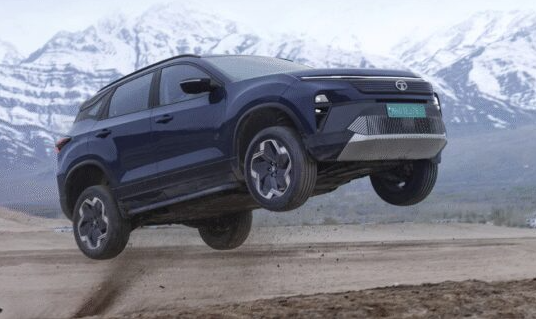
Talking about the variants and pricing first, the Harrier EV RWD is offered in a total of five variants and two battery pack options – 65 kWh and 75 kWh. The 65 kWh is available in Adventure, Adventure S and Fearless Plus priced at Rs 21.49 lakh, Rs 21.99 lakh and Rs 23.99 lakh (all prices, ex-showroom). The bigger 75 kWh battery pack is offered in Fearless Plus and Empowered, priced at Rs 24.99 lakh and Rs 27.49 lakh (both prices, ex-showroom). The pricing for the top-end Empowered AWD variant has not been revealed yet. The cost of the AC fast charger and its installation will be charged separately.

Now, talking about the battery and e-motor, as mentioned previously, the Harrier EV RWD is offered with two LFP battery pack options – 65 kWh and 75 kWh. Both come paired to a single e-motor placed on the rear axle, pushing 238 hp of power. The AWD variant gets a 75kWh LFP battery and dual electric motors—one on each axle—delivering a total output of 313 hp and 504Nm of torque. With Boost mode activated, this version can accelerate from 0 to 100kph in just 6.3 seconds.Talking about the range, the Harrier EV’s 75kWh RWD and AWD versions offer an MIDC-certified range of up to 627km and 622km, respectively, on a full charge. Talking about the charging, the SUV takes approximately 10.7 hours to go from 10 to 100 per cent using a 7.2kW AC charger, while a 120kW DC fast charger can top up the battery from 20 to 80 per cent in just 25 minutes (both claimed).
In terms of features, the new Harrier EV gets a larger 14.53-inch infotainment screen with a Samsung Neo QLED display, a 10.25-inch digital driver’s display, a four-spoke steering wheel with an illuminated Tata logo, a touch-based HVAC control panel, a rotary selector for the six terrain modes – Normal, Snow/Grass, Mud-Ruts, Sand, Rock Crawl, Custom – and electronic parking brake. Other features include a panoramic sunroof, ambient lighting, ventilated and powered front seats, powered Boss mode for the second row, 10-speaker JBL sound system with Dolby Atmos 5.1, powered tailgate, vehicle-to-load (V2L) and vehicle-to-vehicle (V2V) functionality, all-digital inside rearview mirror, and auto park assist.It also gets TiDAL (Tata Intelligent Digital Architecture Layer) that powers the SUV’s connected car features, such as over-the-air (OTA) updates, voice commands, a 540-degree surround camera, and a new DrivePay feature that eliminates the need for a mobile device for FASTag and EV charging point payments. Safety-wise, the EV gets seven airbags, a 360-degree camera, a built-in dashcam, a car blind spot monitor, electronic stability control (ESC), Level 2 ADAS and more.